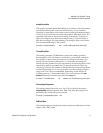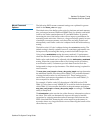StorNext File System Tuning
The Metadata Controller System
StorNext File System Tuning Guide 16
• Identify read/modify/write condition.
If buffered VFS writes are causing Device reads, it might be beneficial
to match I/O request size to a multiple of the “cachebufsize” (default
64KB; see
mount_cvfs man page). Another way to avoid this is by
truncating the file before writing.
The cvadmin command includes a latency-test utility for measuring the
latency between an FSM and one or more SNFS clients. This utility causes
small messages to be exchanged between the FSM and clients as quickly
as possible for a brief period of time, and reports the average time it took
for each message to receive a response.
The latency-test command has the following syntax:
latency-test index-number [seconds]
latency-test all [seconds]
If an index-number is specified, the test is run between the currently-
selected FSM and the specified client. (Client index numbers are
displayed by the cvadmin who command). If all is specified, the test is
run against each client in turn.
The test is run for 2 seconds, unless a value for seconds is specified.
Here is a sample run:
snadmin (lsi) > latency-test
Test started on client 1 (bigsky-node2)... latency 55us
Test started on client 2 (k4)... latency 163us
There is no rule-of-thumb for “good” or “bad” latency values. Latency
can be affected by CPU load or SNFS load on either system, by unrelated
Ethernet traffic, or other factors. However, for otherwise idle systems,
differences in latency between different systems can indicate differences
in hardware performance. (In the example above, the difference is a
Gigabit Ethernet and faster CPU versus a 100BaseT Ethernet and a slower
CPU.) Differences in latency over time for the same system can indicate
new hardware problems, such as a network interface going bad.
If a latency test has been run for a particular client, the cvadmin who
long command includes the test results in its output, along with
information about when the test was last run.


















